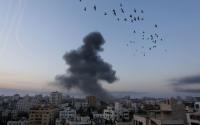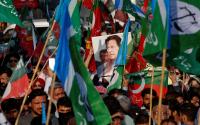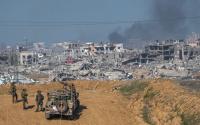Stephen R. Shalom December 15, 2003
Saddam Hussein is one of the world's great monsters. Nothing would be more welcome than to have him put on trial, a trial which could offer Iraqis and the world an honest accounting of his many crimes. However, as so often happens, when a trial is organized by those who are themselves guilty of serious crimes, truth is not the goal. Instead the historical record is falsified to make the one monster seem uniquely blameworthy and the ones running the show above criticism.
We saw this pattern in the Tokyo trials following World War II, where the crimes of Japanese officials were documented in gruesome detail (except for the biological warfare programs, which Washington wanted to use for itself and except for the involvement of the emperor, who was to serve U.S. purposes during the occupation), while the crimes of the victors, such as the horrific fire-bombing raids and the destruction of Hiroshima and Nagasaki, were disregarded. Likewise, Panamanian ruler Manual Noriega was a thug who certainly belonged in the dock. But when the U.S. military invaded Panama in violation of international law and seized him for trial in the United States, there was no intention by the kidnappers that the trial be a forum for revealing the long-time ties between Noriega and the U.S. government, and particularly between Noriega and former CIA director George H. W. Bush.
It is a matter of principle in Washington that Americans not be held to the same international standards as others. Thus, the U.S. refuses to endorse the International Criminal Court and demands that its allies give up their right to invoke the jurisdiction of the court when U.S. citizens are involved. But those of us who truly care about justice ought to demand that Saddam Hussein be tried before a court that is in no way subject to U.S. control or manipulation. Only in that way can the real truth come out.
Already, however, much of the media is falling into line in framing the crimes of Saddam Hussein. For example, the Washington Post website offered a summary of "Events in the Life of Saddam Hussein" from the Associated Press. But the chronology was seriously incomplete. Below is that chronology, corrected to include -- indented and in brackets -- some of the most serious omissions..
Sunday, December 14, 2003; 8:34 AM
A glance at the life of former Iraqi President Saddam Hussein:
April 28, 1937 -- Born in village near desert town of Tikrit, north of Baghdad.
1957 -- Joins underground Baath Socialist Party.
1958 -- Arrested for killing his brother-in-law, a Communist, spends six months in prison.
Oct. 7, 1959 -- On Baath assassination team that ambushes Iraqi strongman Gen. Abdel-Karim Kassem in Baghdad, wounding him. Saddam, wounded in leg, flees to Syria then Egypt.
[This was not the only attempt to assassinate Kassem. In April 1960, the CIA approved using a poisoned handkerchief to kill Kassem. The "handkerchief was duly dispatched to Kassem, but whether or not it ever reached him, it certainly did not kill him." (Thomas Powers, The Man Who Kept the Secrets: Richard Helms and the CIA, New York: Knopf, 1979, p. 130.)]
Feb. 8, 1963 -- Returns from Egypt after Baath takes part in coup that overthrows and kills Kassem. Baath ousted by military in November.
[The coup was backed by the CIA.
"As its instrument the C.I.A. had chosen the authoritarian and anti-Communist Baath Party, in 1963 still a relatively small political faction influential in the Iraqi Army. According to the former Baathist leader Hani Fkaiki, among party members colluding with the C.I.A. in 1962 and 1963 was Saddam Hussein....
"According to Western scholars, as well as Iraqi refugees and a British human rights organization, the 1963 coup was accompanied by a bloodbath. Using lists of suspected Communists and other leftists provided by the C.I.A., the Baathists systematically murdered untold numbers of Iraq's educated elite -- killings in which Saddam Hussein himself is said to have participated. No one knows the exact toll, but accounts agree that the victims included hundreds of doctors, teachers, technicians, lawyers and other professionals as well as military and political figures." (Roger Morris, "A Tyrant 40 Years in the Making," New York Times, March 14, 2003, p. A29.)]
July 17, 1968 -- Baathists and army officers overthrow regime.
["Again, this coup, amid more factional violence, came with C.I.A. backing. Serving on the staff of the National Security Council under Lyndon Johnson and Richard Nixon in the late 1960's, I often heard C.I.A. officers -- including Archibald Roosevelt, grandson of Theodore Roosevelt and a ranking C.I.A. official for the Near East and Africa at the time -- speak openly about their close relations with the Iraqi Baathists." (Morris, "A Tyrant 40 Years in the Making," p. A29.)]
July 30, 1968 -- Takes charge of internal security after Baath ousts erstwhile allies and authority passes to Revolutionary Command Council under Ahmed Hassan al-Bakr, Saddam's cousin.
[From 1973-75, the United States, Iran, and Israel supported a Kurdish insurgency in Iraq. Documents examined by the U.S. House Select Committee on Intelligence "clearly show that the President, Dr. Kissinger and the [Shah] hoped that our clients [the Kurds] would not prevail. They preferred instead that the insurgents simply continue a level of hostilities sufficient to sap [Iraqi] resourcesY. This policy was not imparted to our clients, who were encouraged to continue fighting. Even in the context of covert action, ours was a cynical enterprise." Then, in 1975, the Shah and Saddam Hussein of Iraq signed an agreement giving Iran territorial concessions in return for Iran's closing its border to Kurdish guerrillas. Teheran and Washington promptly cut off their aid to the Kurds and, while Iraq massacred the rebels, the United States refused them asylum. Kissinger justified this U.S. policy in closed testimony: "covert action should not be confused with missionary work." (U.S. House of Representatives, Select Committee on Intelligence, 19 Jan. 1976 [Pike Report] in Village Voice, 16 Feb. 1976, pp. 85, 87n465, 88n471. The Pike Report attributes the last quote only to a "senior official"; William Safire, Safire's Washington, New York: Times Books, 1980, p. 333, identifies the official as Kissinger.)]
July 16, 1979 -- Takes over as president from al-Bakr, launches massive purge of Baath.
[In the late 1970s, Saddam also purged the Iraqi Communist Party and other oppositionists. (Marion Farouk-Sluglett and Peter Sluglett, Iraq Since 1958, London: I. B. Tauris, 1990, pp. 182-87) "We see no fundamental incompatibility of interests between the United States and Iraq," declared U.S. National Security adviser Zbigniew Brzezinski in April 1980. (Quoted in Barry Rubin, "The United States and Iraq: From Appeasement to War," in Iraq's Road to War, ed. Amatzia Baram and Barry Rubin, New York: St. Martin's 1993, p. 256.)]
Sept. 22, 1980 -- Sends forces into Iran; war last eight years.
[When Iraq invaded Iran, the United Nations Security Council waited four days before holding a meeting. On September 28, it passed Resolution 479 calling for an end to the fighting, but which significantly did not condemn (nor even mention) the Iraqi aggression and did not demand a return to internationally recognized boundaries. As Ralph King, who has studied the UN response in detail, concluded, "The Council more or less deliberately ignored Iraq's actions in September 1980." The U.S. delegate noted that Iran, which had itself violated Security Council resolutions on the U.S. embassy hostages, could hardly complain about the Council's lackluster response. (R.P.H. King, "The United Nations and the Iran-Iraq War, 1980-1986," in The United Nations and the Iran-Iraq War, ed. Brian Urquhart and Gary Sick, New York: Ford Foundation, August 1987.)
Despite the fact that Iraq had been the aggressor in this war and that Iraq was the first to use chemical weapons, the first to launch air attacks on cities, and the initiator of the tanker war, the United States tilted toward Iraq. The U.S. removed Iraq from its list of terrorist states in 1982, sent Donald Rumsfeld to Baghdad as Reagan's envoy to meet with Saddam Hussein in 1983 and 1984 to discuss economic cooperation, re-established diplomatic relations in November 1984, made available extensive loans and subsidies, provided intelligence information, encouraged its allies to arm Iraq, and engaged in military actions in the Persian Gulf against Iran. The United States also provided dual-use equipment that it knew Iraq was using for military purposes. (See Joyce Battle, ed., "Shaking Hands with Saddam Hussein: The U.S. Tilts toward Iraq, 1980-1984," National Security Archive Electronic Briefing Book No. 82, Feb. 25, 2003, http://www.gwu.edu/~nsarchiv/NSAEBB/NSAEBB82/.)]
March 28, 1988 -- Uses chemical weapons against Kurdish town of Halabja, killing estimated 5,000 civilians.
[From Iraq's first use of chemical weapons in 1983, the U.S. took a very restrained view. When the evidence of Iraqi use of these weapons could no longer be denied, the U.S. issued a mild condemnation, but made clear that this would have no effect on commercial or diplomatic relations between the United States and Iraq. Iran asked the Security Council to condemn Iraq's chemical weapons use, but the U.S. delegate to the U.N. was instructed to try to prevent a resolution from coming to a vote, or else to abstain. An Iraqi official told the U.S. that Iraq strongly preferred a Security Council presidential statement to a resolution and did not want any specific country identified as responsible for chemical weapons use. On March 30, 1984, the Security Council issued a presidential statement condemning the use of chemical weapons, without naming Iraq as the offending party. (Battle, http://www.gwu.edu/~nsarchiv/NSAEBB/NSAEBB82/.)
At the same time that the U.S. government had knowledge of that the Iraqi military was using chemical weapons, it was providing intelligence and planning assistance to the Iraqi armed forces. (Patrick Tyler, "Officers Say U.S. Aided Iraq In War Despite Use Of Gas," New York Times, Aug. 18, 2002, p. 1.)
When Iraq used chemical weapons in March 1988 against Halabja, there was no condemnation from Washington. (Dilip Hiro, "When US turned a blind eye to poison gas," The Observer, September 1, 2002, p. 17.) "In September 1988, the House of Representatives voted 388 to 16 in favor of economic sanctions against Iraq, but the White House succeeded in having the Senate water down the proposal. In exchange for Export-Import Bank credits, Iraq merely had to promise not to use chemical weapons again, with agricultural credits exempted even from this limited requirement." (Rubin, "The United States and Iraq: From Appeasement to War," p. 261.)]
Aug. 2, 1990 -- Invades Kuwait.
[The chronology omits one of Saddam Hussein's most egregious atrocities, his Anfal campaign against the Kurds from 1987-89, in which at least 50,000 and possibly 100,000 Kurds were systematically slaughtered. (Middle East Watch, Genocide in Iraq: The Anfal Campaign Against the Kurds, New York: Human Rights Watch, 1993.)
The response of the new Bush administration was to increase Iraq's commodity credits from half a billion to a billion dollars, making it the second largest user of the credit program in the world. As late as April 1990, the administration was opposing sanctions against Iraq ("They would hurt U.S. exporters and worsen our trade deficit," said the State Department). (Guy Gugliotta, Charles R. Babcock, and Benjamin Weiser, "At War, Iraq Courted U.S. Into Economic Embrace," Washington Post, Sept. 16, 1990, p. A1.) The administration also blocked efforts to cut back high-tech exports to Iraq with obvious military applications. (Douglas Frantz and Murray Waas, "Bush insisted on aiding Iraq until war's onset," Chicago Sun-Times, Feb. 23, 1992, p. 17.) And the United States was providing intelligence data to Iraq until three months before the invasion. (Murray Waas, Douglas Frantz, "U.S. shared intelligence with Iraq until 3 months before invasion of Kuwait," Houston Chronicle, March 10, 1992, p. A6.)]
Jan. 17, 1991 -- Attacked by U.S.-led coalition; Kuwait liberated in a month.
[As part of the U.S.-led attack, the civilian infrastructure of Iraq was intentionally targeted (Barton Gellman, "Allied Air War Struck Broadly in Iraq; Officials Acknowledge Strategy Went Beyond Purely Military Targets," Washington Post, 23 June 1991, p. A1; Thomas J. Nagy, "The Secret Behind the Sanctions," Progressive, Sept. 2001), which together with more than a decade of economic sanctions would lead to hundreds of thousands of excess deaths. (See Richard Garfield, "Morbidity and Mortality Among Iraqi Children From 1990 through 1998: Assessing the Impact of the Gulf War and Economic Sanctions," March 1999, http://www.fourthfreedom.org/php/t-si-index.php?hinc=garf-index.hinc.)]
March, 1991 -- Crushes Shiite revolt in south and Kurd revolt in north.
[After urging Iraqis to rise up against Saddam Hussein, the U.S. denied the rebels access to captured Iraqi weapons and allowed Saddam Hussein to use his helicopters to slaughter the insurgents as U.S. aircraft circled overhead. (Andrew Cockburn and Patrick Cockburn, Out of the Ashes: The Resurrection of Saddam Hussein, New York: Harperperennial. 1999, chap. 1)]
April 17, 1991 -- Complying with U.N. Resolution 687, starts providing information on weapons of mass destruction, but accused of cheating.
Feb. 20, 1996 -- Orders killing of two sons-in-law who in 1995 defected to Jordan and had just returned to Baghdad after receiving guarantees of safety.
Dec. 16, 1998 -- Weapons inspectors withdrawn from Iraq. Hours later, four days of U.S.-British air and missile strikes begin as punishment for lack of cooperation.
[The bombing was conducted without Security Council approval and without consultations with allies. The withdrawal of the inspectors was ordered by Richard Butler, the head of UNSCOM. "France was also annoyed with Washington for getting Mr. Butler to pull out his inspectors from Iraq without discussion with the Security Council." U.S. Secretary of State "Albright did not speak with Secretary General Kofi Annan at the United Nations, officials said. Mr. Annan issued a personal statement, calling this 'a sad day' for the world and 'me personally,' because of his failure to avert the use of force." (Steven Erlanger, "U.S. Decision to Act Fast, and Then Search for Support, Angers Some Allies," New York Times, Dec. 17, 1998, p. A14.)]
Nov. 8, 2002 -- Threatened with "serious consequences" if he does not disarm in U.N. Security Council resolution.
Nov. 27, 2002 -- Allows U.N. experts to begin work in Iraq for first time since 1998.
Dec. 7, 2002 -- Delivers to United Nations declaration denying Iraq has weapons of mass destruction; later, United States says declaration is untruthful and United Nations says it is incomplete.
March 1, 2003 -- United Arab Emirates, at an Arab League summit, becomes first Arab nation to propose publicly that Saddam step down.
March 7 -- United States, Britain and Spain propose ordering Saddam to give up banned weapons by March 17 or face war; other nations led by France on polarized U.N. Security Council oppose any new resolution that would authorize military action.
March 17 -- United States, Britain and Spain declare time for diplomacy over, withdraw proposed resolution. President Bush gives Saddam 48 hours to leave Iraq.
[Actually, U.S. officials made clear that U.S. troops would enter Iraq whether or not Saddam and his sons left the country. (Michael R. Gordon, "Allies Will Move In, Even if Saddam Hussein Moves Out," New York Times, March 18, 2003, p. A16.)]
March 18 -- Iraq's leadership rejects Bush's ultimatum.
["On the eve of war, Iraq publicly offered unlimited access for American and British weapons hunters." (David Rennie, "Saddam 'offered Bush a huge oil deal to avert war'," Daily Telegraph [London], Nov. 7, 2003, p. 17) And privately Iraq went well beyond this. In several back-channel contacts with U.S. officials, Iraq offered the U.S. "direct U.S. involvement on the ground in disarming Iraq," oil concessions, the turn-over of a wanted terrorist, cooperation on the Israeli-Palestinian peace-process, and even internationally-supervised elections within two years. (James Risen, "Iraq Said to Have Tried to Reach Last-Minute Deal to Avert War," New York Times, Nov. 6, 2003, p. A1) One doesn't know where these offers may have led, since they were rejected by the U.S.: "A US intelligence source insisted that the decision not to negotiate came from the White House, which was demanding complete surrender. According to an Arab source, [a U.S. intermediary] sent a Saudi official a set of requirements he believed Iraq would have to fulfill. Those demands included Saddam's abdication and departure, first to a US military base for interrogation and then into supervised exile, a surrender of Iraqi troops, and the admission that Iraq had weapons of mass destruction. (Julian Borger, Brian Whitaker, and Vikram Dodd "Saddam's desperate offers to stave off war," Guardian, Nov. 7, 2003, p. 3.)]
March 20 -- U.S. forces open war with military strike on Dora Farms, a target south of Baghdad where Saddam and his sons are said to be. Saddam appears on Iraqi television later in the day.
April 4 -- Iraqi television shows video of Saddam walking a Baghdad street.
April 7 -- U.S. warplanes bomb a section of the Mansour district in Baghdad where Saddam and his sons were said to be meeting.
April 9 -- Jubilant crowds greet U.S. troops in Baghdad, go on looting rampages, topple 40-foot statue of Saddam.
July 22 -- Saddam's sons, Qusai and Odai, killed in gunbattle with U.S. troops. American forces then raid the northern city of Mosul and later say they missed Saddam "by a matter of hours."
July 27 -- U.S. troops raid three farms in Tikrit. Again, officials later say they missed Saddam by 24 hours.
July 31 -- Two of Saddam's daughters, Raghad and Rana, and their nine children are given asylum by Jordan's King Abdullah II.
[That they would need asylum follows from the U.S. policy of detaining family members of those they are seeking, in violation of elementary standards of justice. ("The arrest of close relatives of fugitive regime members has been used by US forces in the past both as a way to gather intelligence - through interrogation - and to put emotional pressure on the hunted men to surrender." Colin Nickerson, "US Troops Detain Wife, Daughter Of Key Hussein Aide Ex-Deputy Suspected Of Plotting Attacks In Iraqi Insurgency," Boston Globe, Nov. 27, 2003, p. A40.)]
Sept. 5 -- Maj. Gen. Ray Odierno of the 4th Infantry Division says his troops have captured several of Saddam's former bodyguards in the Tikrit area in the past month and may be closing in on the deposed Iraqi dictator.
Nov. 16 -- The last of nine tapes attributed to Saddam Hussein since he was removed from power is released. It tells Iraqis to step up their resistance to the U.S.-led occupation, saying the United States and its allies misjudged the difficulty of occupying Iraq.
[It didn't take a genius to note that "the United States and its allies misjudged the difficulty of occupying Iraq."]
Dec. 13 -- Saddam is captured at 8:30 p.m. in the town of Adwar, 10 miles south of Tikrit. He is hiding in a specially prepared "spider hole."






